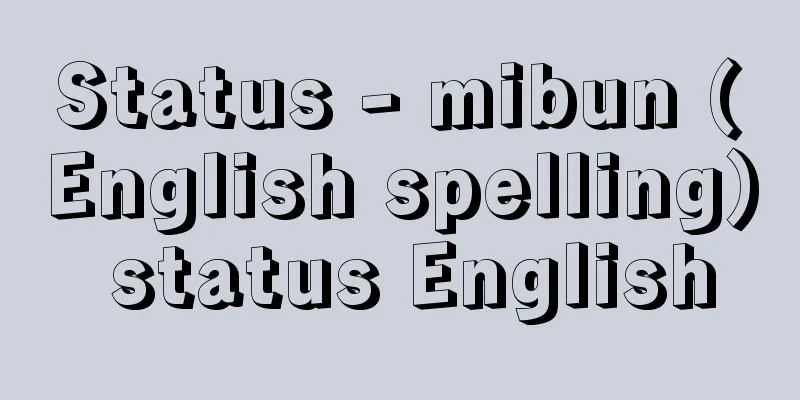Enkan

|
A Tendai Buddhist monk, his given name was Echin and his imperial title was Ji. He was born in Omi (Shiga Prefecture). At the age of 15, he entered Mount Hiei and was ordained. At the age of 18, he listened to a lecture by Denshin Kouen (1262-1317) for the first time. He later aspired to become a hermit and left the Zen sect for a time, but in 1305 (Kagen 3), he returned to Mount Hiei and, together with his teacher Kouen, attempted to revive the Enkai (Entonkai) sect, which was on the verge of extinction. After his teacher's death, he devoted himself to promoting it. He founded Gen'o-ji Temple and became the chief monk for the construction of Hossho-ji Temple. He participated in Emperor Godaigo's plan to overthrow the shogunate, and in 1331 (Ganko 1) he and Monkan (1278-1357) and others put an act of curse on the Hojo clan, for which he was arrested at Rokuhara and exiled to Mutsu. He returned to Kyoto when the Kenmu government was established. He gained the patronage of Ashikaga Takauji, and in 1334 (Kenmu 1) he became the founder of Hokai-ji Temple in Kamakura. After Takauji and Emperor Godaigo defected from the Shogunate, he worked in cooperation with the Northern Court, but he also gained the trust of the Southern Court, and often acted as an intermediary between the two courts. It is said that he was the precept master of Emperors Gofushimi, Hanazono, Godaigo, Komyo, and Kogon. His disciples included Mitsumune (1276-1350) and Iken (1289-1378), and he left behind many writings on the subject of perfect precepts. [Hiromi Tanaka May 19, 2017] [Reference item] | |Source: Shogakukan Encyclopedia Nipponica About Encyclopedia Nipponica Information | Legend |
|
天台宗の僧。諱(いみな)を慧鎮(えちん)、勅賜号を慈威(じい)という。近江(おうみ)(滋賀県)に生まれる。15歳で比叡(ひえい)山に入り、登壇受戒、18歳のとき初めて伝信興円(でんしんこうえん)(1262―1317)の談義を聴聞する。その後遁世行道(とんぜいぎょうどう)を志し、一時は禅門をくぐるが、1305年(嘉元3)ふたたび叡山に帰り、師興円とともに廃絶に瀕(ひん)していた円戒(円頓戒)の再興を図り、師の寂後もっぱらその宣揚に努める。元応寺(げんおうじ)を創(はじ)め、法勝(ほっしょう)寺修造大勧進となる。後醍醐(ごだいご)天皇の討幕計画に参画、1331年(元弘1)文観(もんかん)(1278―1357)らとともに北条氏を呪咀(じゅそ)、そのために六波羅(ろくはら)に捕らえられ、陸奥(むつ)に流された。建武(けんむ)政権の成立とともに帰京。足利尊氏(あしかがたかうじ)の帰依を受け、1334年(建武1)鎌倉宝戒(ほうかい)寺開山となる。尊氏と後醍醐天皇が離反してからは、北朝方と結んで活動するが、南朝方からも信任を得、しばしば両朝の間を斡旋(あっせん)した。後伏見(ごふしみ)、花園(はなぞの)、後醍醐、光明(こうみょう)、光厳(こうごん)天皇の戒師となったと伝える。弟子に光宗(こうそう)(1276―1350)、惟賢(いけん)(1289―1378)らがあり、円戒に関する多くの著述を遺(のこ)した。 [田中博美 2017年5月19日] [参照項目] | |出典 小学館 日本大百科全書(ニッポニカ)日本大百科全書(ニッポニカ)について 情報 | 凡例 |
<<: Coastal Fisheries - Engangyogyo
Recommend
Kiyohara Yorinari - From Kiyohara
Year of death: Bunji 5, leap year 4, 14 (1189.5.30...
《Evil Spirit》
...The incident came to light, and about a month ...
Nogurumi - Nogurumi
A deciduous tree of the walnut family that grows i...
Sulfinyl chloride
...Common name for sulfinyl chloride. Chemical fo...
Grains of Paradise
…In any case, the value of the “grains of paradis...
beylerbeyi
...their holders were called alaybeyi (subaşı) an...
Jia Sixie - Kashikyo
Date of birth and death unknown. Author of "...
Review - Hyobanki
Books that reviewed various things during the Edo...
Jörg Wickram
1505?‐62? German novelist. Born and raised in Colm...
Agency of Industrial Science and Technology
A special organization established under the Mini...
Torinji Temple
A temple located at the northwest foot of Mount Lu...
Zen temple architecture
Eisai introduced Zen Buddhism from Song and founde...
Eagle (Warship)
…Japan completed the Shoukaku and Zuikaku just be...
Fyodor Kuzmich Sologub
Russian novelist and poet. His real name was Tete...
Angara shield
A stable continental region since the Paleozoic er...









